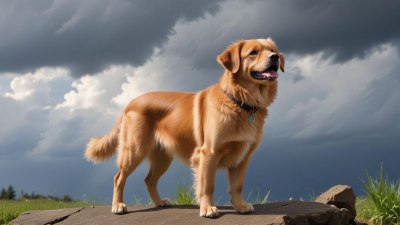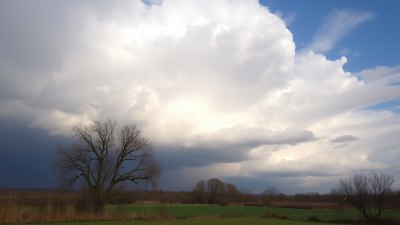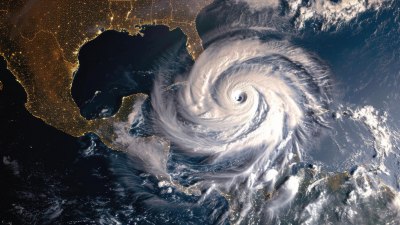How Pets Change Their Habits with Weather — and Take You Along
Explore how weather affects pet behavior and habits, and tips for owners to adapt.

This image was created with the assistance of Freepik
Pets, much like humans, are influenced by the changing seasons and varying weather conditions. Their habits and behaviors can shift significantly depending on the temperature, precipitation, and even atmospheric pressure. Understanding these changes can help pet owners better adapt to their furry friends' needs, ensuring a happy and healthy environment. In this article, we will delve into how pets respond to different weather conditions and the impact these changes have on their daily routines.
How Weather Influences Pet Behavior
The relation between weather and pet behavior is intricate. Many pet owners notice distinct behavioral shifts in their animals marked by the changing seasons. For example, dogs may become more energetic and eager to play when the sun is shining bright, while cats may seek out warm spots in the house during chilly days. Understanding these behavioral changes requires observing your pet's reactions to different weather elements.
Temperature Changes
One of the most noticeable aspects of weather that affects pets is temperature. Both dogs and cats are sensitive to heat and cold, which can dictate their exercise habits, sleeping patterns, and willingness to engage in outdoor activities. In extremes of weather, pets can exhibit changes in appetite and energy levels. During hot summer days, dogs may prefer to rest indoors in cool areas, thereby reducing their overall activity level. Conversely, in colder months, they may refuse to go outside at all, opting for cozy spots inside to avoid the bite of the cold.
Rainy and Humid Weather
Rainy days bring another set of challenges for pets. Many pets, particularly dogs, may be reluctant to go outside when it's raining. The pitter-patter of raindrops and the smell of wet ground can be intimidating for some animals, leading to altered bathroom habits or decreased willingness to engage in play. On the other hand, some pets actually enjoy playing in the rain, particularly those with higher energy levels. However, wet weather can also lead to concerns regarding hygiene and health, as pets are more prone to mud and dirt. It's essential for pet owners to be prepared for these possible changes and approach rainy walks with understanding. Providing them with raincoats or towels can make these excursions easier for both parties.
Windy Conditions
Wind can have an influential effect on pet behavior as well. Many animals can be sensitive to sound, and when the wind carries sounds that may not be typically audible, it can cause confusion or stress. Dogs may bark more frequently or show signs of anxiety when the wind howls. Cats may find comfort in finding a safe place to hide, away from the turbulent sounds. Owners should remain vigilant during particularly windy days and provide a calming environment for their pets, ensuring they feel secure and less stressed by the unsettling atmosphere.
Seasonal Changes and Social Behavior
With the coming of spring and summer, pet owners often notice an increase in social interactions among pets. Dogs, for instance, may enjoy group playdates at the park or beach outings with their owners. This season encourages outdoor exploration, fostering a sense of adventure. Alongside this, many pet owners also experience impulse-driven behaviors from their pets as they are driven to explore new scents and sights. This behavior is vital to their mental stimulation and can lead to healthier, happier animals.
Preparing for Seasonal Changes
It is crucial for pet owners to prepare for the season ahead, accounting for how various weather conditions will affect their pets’ behavior. During hot weather, keeping pets hydrated and providing shady areas for rest can keep them healthy. In the cold months, investing in pet jackets or heated pet beds can dramatically increase comfort. Furthermore, routine adjustments such as changing walk times or locations can help maintain an active lifestyle for your pet, adapting with the seasons to keep them stimulated physically and mentally.
Adapting to Changes in Exercise Habits
As weather plays a crucial role in determining our pets' exercise habits, owners must find alternative ways to ensure their pets are still receiving adequate physical activity. On excessively hot or cold days, shorter walks can be beneficial, supplemented by indoor playtime using toys that encourage movement. Games like fetch or hide-and-seek can be done inside the house, keeping pets engaged and entertained even when the weather doesn't permit outdoor activities.
Health Considerations During Weather Changes
It is important to monitor your pets for any health issues that could be exacerbated by weather changes. For instance, as temperature dips, older pets or those with arthritis may require special care due to joint pains exacerbated by cold. Likewise, during hotter months, pets can suffer from heatstroke if not monitored properly. Understanding these risks and keeping a vigilant eye on your pet’s health can make a significant difference in their comfort level and overall well-being.
Behavioral Training Related to Weather
Training your pet to adapt to changing weather conditions can also enhance their behavior during various situations. For fearful pets, positive reinforcement techniques can help them associate sounds like thunder or strong winds with rewards, calming their nerves. Reinforcement training can also be beneficial for developing proper bathroom habits during rain or snow. Teaching your pet to use specific areas for their needs can ease the process and minimize stress both for the animal and the owner.
Fostering a Positive Weather Experience
Creating a positive environment during unfavorable weather is equally important. Pet owners should strive to maintain a routine while adapting to the external atmosphere. Keeping their living spaces comfortable, whether that means heating during winter or cooling during summer, helps alleviate stress. Providing extra attention during tough weather days not only comforts pets but also strengthens the bond between animals and their owners. Engaging pets with toys or exercises tailored to their specific needs can make adverse weather conditions a more positive experience.
The Importance of Observation
As the weather changes, so too can your pet's needs and habits. To foster a better relationship with your animals, owners should make a point of keenly observing changes in their pets' behaviors. An ice-cold day can deter dogs from walks while a sunny afternoon might invigorate them to explore the outdoors. Paying attention to these signals will allow owners to adapt their routines accordingly, ensuring their pets receive the love and care they deserve.
Embracing Our Furry Friends
In conclusion, weather reveals a complex interplay that deeply affects our pets’ behaviors and habits. From temperature and humidity to seasonal changes, understanding these elements helps owners respond thoughtfully to their pets' needs. This not only promotes the health and welfare of our furry friends but also provides opportunities for enriching bonding experiences. By being proactive in recognizing how weather affects our pets, we can create a nurturing atmosphere that enhances their lives and strengthens the ties we share with them as beloved companions.











